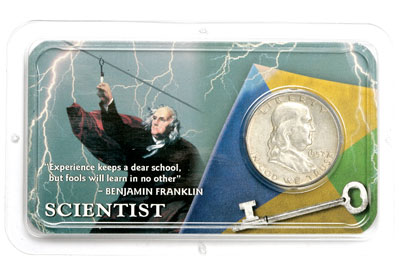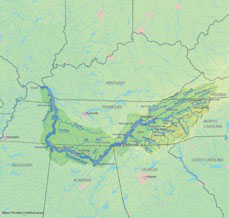Positively electrifying!
After the discovery of fire as an energy source, man’s next quantum leap was electricity. Nowhere was the need more crucial than in the Tennessee River Valley in the 1930s. But almost 200 years would pass before electricity went from a seeming stunt performed by Benjamin Franklin to the result of dams used both for power generation and flood control in seven southern states.
Lightning in a Bottle

Who hasn’t seen static electricity? With hair? Or, from clothing? In the early 18th century though, capturing evidence of electricity was a popular parlor trick. Ever the tinkerer, Franklin flew a kite with a wire attached to the top, plus a key to the tail, during a thunderstorm to divert lightning into a special jar. His circa 1750 experiment confirmed the bolt was an electrical discharge. His initial solution? Place a pointed metal rod on a rooftop to divert lightning from setting fire to a building.
What Hath God Wrought?
To British scientist Michael Faraday goes the credit for discovering that an electric current could be produced using a magnet and copper wire. But it was to American painter Samuel F.B. Morse that credit is due for figuring out how to relay that electric current for miles. He received his patent in 1844. In the following decades, telegraph poles erected along the nation’s growing trail of railroad tracks signaled that a new era of essential services was dawning.
Except, perhaps, in the Tennessee River Valley. In 1847, it sustained a major flood. And, not for the first time. A localized surge in 1808 severely impacted Knoxville, site of the Tennessee’s headwaters in the eastern part of the state.

The rural South’s 652-mile river and its many estuaries, in fact, caused many floods. All cost lives, ruined farmland, and destroyed villages where mills relied on water power. And even as electric lights were gaining favor in America’s metropolitan areas, kerosene was still used by a lot of rural residents.
The Menlo Park Wizard
Surpassing Franklin at tinkering with solutions, uber inventor Thomas A. Edison came up with a long-lasting light bulb in his New Jersey laboratory in 1879. It made electricity far more efficient than gas or kerosene for providing illumination. Before too long, investors found opportunities to finance regional electrical grids that could power everything from street cars to sewing machines.
The United States raced to cement its technological advantage in the world. The Bureau of Engraving and Printing released a spectacular $5 silver certificate named Electricity as the Dominant Force in the World as part of its now-famous Educational Notes Series in 1896. Allegorical figures depicted Electricity Presenting Light to the World: Fame heralded Electricity’s achievement, Jupiter held the lightning to power Electricity’s lamp, and Peace rose above the U.S. Capitol.
Floods and FDR
But for rural America, especially the South, the 20th century’s promise didn’t pan out as hoped. In 1927, tributaries in the Tennessee River Valley caused more flooding. Two years later followed the Wall Street Crash, and investment money dried up. Moreover, as the Great Depression deepened, nine out of ten rural homes were still without electricity.

Carefully campaigning for election in 1932, Franklin D. Roosevelt promised to reform the economy with government regulations and address gaps in farming, finance, labor, housing and hydropower. Once sworn into office, FDR asked Congress to establish a public utility to bring relief to the South. On May 18, 1933, Congress created the Tennessee Valley Authority (TVA). It charged the TVA with building dams for flood control and erecting transmission lines to serve “farms and small villages that are not otherwise supplied with electricity at reasonable rates.” Between 1933 and 1944, the TVA built 16 hydroelectric dams in the valley. In the 21st century, there are 29.
But in 1936, nearly 90 percent of American farms lacked electric power because the cost to get electricity to rural areas was prohibitive. So, the TVA organized an experimental farmer-owned rural electric cooperative to serve the greater Tupelo, MS area. The co-op succeeded, and the federal government instituted a new agency.
Known as the Rural Electrification Administration, it gave loans and other help to rural organizations setting up their own power systems. By 1939, the REA had helped establish 417 rural electric cooperatives across the United States. The 2022 American Innovation dollar coin representing Tennessee recognizes the formation of the Tennessee Valley Authority and celebrates the arrival of rural electrification in America.
Sources:
American Physical Society. “December 23, 1750: Ben Franklin Attempts to Electrocute a Turkey.” This Month in Physics History, December 2006 (Volume 15, Number 11). https://www.aps.org/publications/apsnews/200612/history.cfm
Library of Congress. “Invention of the Telegraph.” Accessed September 2, 2022. https://www.loc.gov/collections/samuel-morse-papers/articles-and-essays/invention-of-the-telegraph/
Library of Congress. “Life of Thomas Alva Edison.” Accessed August 31, 2022. https://www.loc.gov/collections/edison-company-motion-pictures-and-sound-recordings/articles-and-essays/biography/life-of-thomas-alva-edison/
Eschner, Kat. “Here’s How FDR Explained Making Electricity Public.” Smithsonian Magazine, May 18, 2017. https://www.smithsonianmag.com/smart-news/heres-how-fdr-explained-making-electricity-public-180963286/
Wallace, Harold D. “Power from the people; Rural Electrification brought more than lights.” February 12, 2016. https://americanhistory.si.edu/blog/rural-electrification
U.S. Department of Agriculture. “Celebrating the 80th Anniversary of the Rural Electrification Administration.” Accessed August 19, 2022. https://www.usda.gov/media/blog/2016/05/20/celebrating-80th-anniversary-rural-electrification-administration



